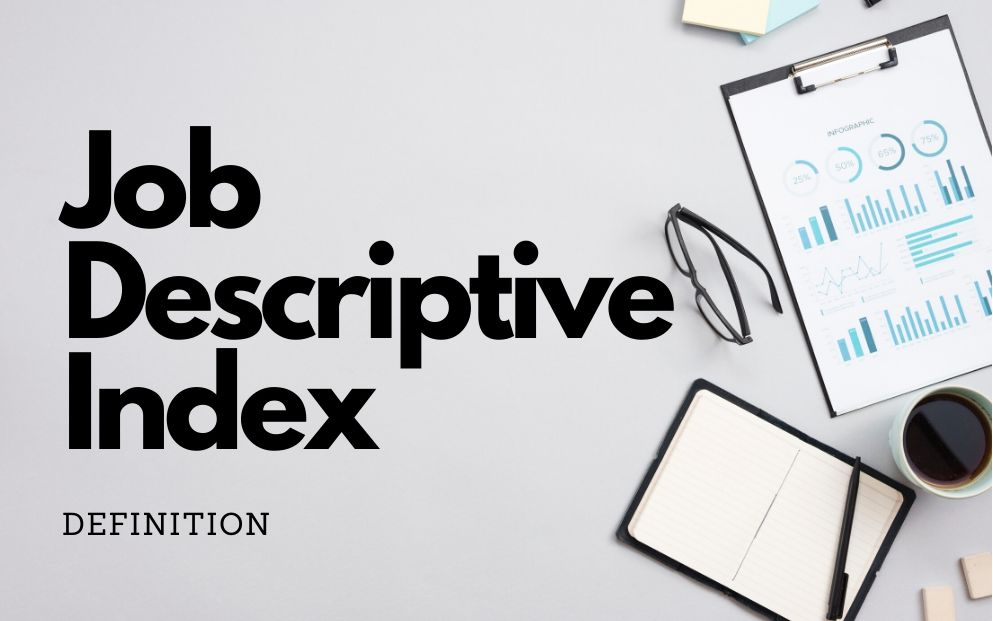Employee happiness is generally seen as positive feelings or emotions that a person might have in relation to their work. Some people feel very satisfied with their work, while others can be very dissatisfied. Both workplace and personal factors appear to play a role in determining job satisfaction. Several decades of research have shown a relatively consistent relationship between employee satisfaction and key organizational outcomes such as employee performance levels and turnover.
What is the Job Descriptive Index
The Job Descriptive Index (JDI) is a 72-point instrument for measuring five dimensions of employee satisfaction: satisfaction with supervision, with coworkers, with pay, with promotion opportunities and with the work itself.
The JDI is perhaps the most widely used measure of employee satisfaction. The JDI was first published in 1969 by Smith, Kendall and Hulin in their classic book “The Measurement of Satisfaction in Work and Retirement”. The JDI is a “facet” measure of employee satisfaction, i.e. employees are asked to think about specific facets of their work and rate their satisfaction with those specific facets. The JDI consists of five facets, including satisfaction with: Employees, the work itself, pay, promotion opportunities and support.
Each scale contains a checklist of adjectives or adjective phrases, and respondents are asked to fill in the box next to each item as follows: “Y” (agree), “N” (disagree) and “?” (can’t decide).
Measuring employee satisfaction
There are many providers who refer to the JDI and support you in implementing it in your company. However, if you would like to get your own impression, you can also take a look at the short version of the instructions. The instructions can be downloaded here as a PDF. The KAFA test is the short version of the JDI and enables anyone to conduct an empirical employee satisfaction test.
The 5 dimensions of the Job Descriptive Index
The Job Descriptive Index (JDI) is an instrument for measuring job satisfaction and examines it on the basis of five different dimensions. Let’s take a closer look at these:
- Satisfaction with the work itself: This dimension measures how satisfied employees are with the tasks, responsibilities and challenges of their work. In short, the question here is: Is the work fun?
- Satisfaction with leadership: This dimension focuses on employees’ satisfaction with their direct supervisors or managers. How well do they communicate, offer support and provide helpful instructions?
- Satisfaction with salary: This dimension analyzes employee satisfaction with their compensation, including salary, benefits and bonuses. This is an important point, as money often plays a decisive role in job satisfaction.
- Satisfaction with career opportunities: This measures how satisfied employees are with the opportunities for professional development, growth and development within the organization. Is there room for professional development?
- Satisfaction with colleagues: This dimension measures how satisfied employees are with their relationships and interactions with colleagues and team members. A good team atmosphere can significantly increase job satisfaction.
The five dimensions provide a comprehensive insight into employees’ job satisfaction and cover various aspects of their working environment and work experiences. By measuring job satisfaction based on these dimensions, companies can identify specific areas for improvement and take targeted measures to increase employee satisfaction and retention. Overall, the JDI helps companies to develop a better understanding of their employees’ needs and thus create a more positive working environment.
Examples of questions in the Job Descriptive Index
The Job Descriptive Index (JDI) is a 72-question questionnaire that measures job satisfaction based on five different dimensions. Here are some examples of questions that may be included in the JDI:
Satisfaction with the work itself:
How interesting is your work?
How challenging is your work?
How varied is your work?
Satisfaction with the management:
How well does your manager communicate with you?
How supportive is your line manager?
How fairly does your manager treat you?
Satisfaction with salary:
How satisfied are you with your salary?
How satisfied are you with your benefits?
How satisfied are you with your overall remuneration package?
Satisfaction with promotion opportunities:
How much opportunity is there for career advancement in your job?
How satisfied are you with the opportunities for professional development in your organization?
How much support do you receive for your professional development?
Satisfaction with colleagues:
How well do you get on with your colleagues?
How much do you enjoy working with your colleagues?
How much do you feel part of a team?
How do I deal with the results of the Job Descriptive Index?
As soon as the results of the Job Descriptive Index (JDI) are available, various steps can be taken to make optimum use of the information. The first step is to analyze the JDI results and identify patterns or trends. Look at the areas in which employees are particularly satisfied or dissatisfied and consider how these results relate to the goals and objectives of your organization.
Based on the JDI results, you can then identify specific areas where improvements can increase employee satisfaction. This may include the introduction of new policies or procedures, additional training or resources, or even changes to the working environment.
Once you have identified the problem areas, develop an action plan to tackle these challenges. This can include setting specific targets, assigning responsibilities and drawing up timetables for implementation.
Another important step is to share the results of the JDI with employees and other stakeholders and communicate how the organization intends to address the issues identified. This can strengthen the trust and loyalty of employees and demonstrate the organization’s willingness to improve employee satisfaction.
To ensure that the organization is making real progress in improving employee satisfaction and retention, it is important to monitor progress on a regular basis. In this way, adjustments can be made if necessary and it can be ensured that the targets set are achieved.
If your company needs support with the implementation of the JDI
For companies that feel a little lost with the Job Descriptive Index (JDI), there is help! I am happy to be at your disposal as a sparring partner.
My aim is to support you in increasing the satisfaction of your employees and creating a better working environment. With my experience and expertise, I can support you in conducting and analyzing the JDI results to identify patterns and trends.
Together, we will identify specific areas where improvements can be made to increase employee satisfaction. We develop action plans that fit your organization, set clear goals and assign responsibilities.
The results and planned measures are communicated openly and clearly in order to build trust and gain the cooperation of employees.
Why is it important to measure employee satisfaction?
Why is it important to measure employee satisfaction at all? Quite simply, there is much more to it than just an issue for the HR department. Here are some good reasons why companies should take the time to measure the mood of their employees:
- Identify problem areas:
Who knows the company better than the people who work there every day? By measuring employee satisfaction, companies can identify problem areas. In this way, targeted measures can be taken to address these problems and improve satisfaction. Whether communication, workload or coffee machine – employees can say what bothers them.
- Increase employee retention:
Satisfied employees stay longer. They are more willing to remain loyal to the company and commit themselves in the long term. Measuring employee satisfaction helps to strengthen employee loyalty and reduce staff turnover. This not only saves money, but also creates a relationship of trust between the company and its employees.
- Improve work performance:
People who feel good at work are more motivated and committed. Companies can increase work performance and productivity by measuring and specifically improving employee satisfaction. Satisfied employees are simply more productive employees.
- Recognize problems early:
Waiting until the child has fallen into the well is a thing of the past. Measuring employee satisfaction enables companies to react to negative developments at an early stage. Regular surveys enable them to recognize changes in satisfaction levels and take timely action to solve potential problems. Many problems can be avoided through early intervention.
- image and attractiveness as an employer:
Today, potential employees don’t just pay attention to salary. They are also interested in the working environment and corporate culture. Companies that take care of their employees’ satisfaction generally have a better image as employers. This can help to attract qualified specialists and position the company as an attractive employer.
Overall, measuring employee satisfaction enables companies to better understand the needs and expectations of their employees and to take targeted measures to improve working conditions and the working environment. This contributes to the creation of a positive corporate culture and promotes the well-being and performance of employees. So it’s more than just a survey – it’s a way to make the company better and more successful.
Closing words
As a result, the Job Descriptive Index (JDI) is a valuable tool for organizations to measure and improve the job satisfaction of their employees. The results of the JDI provide valuable insights into various aspects of the working environment, from the work itself to leadership, salary, promotion opportunities and colleagues. By analyzing these results and translating them into concrete measures, companies can not only increase the satisfaction of their employees, but also boost their commitment and productivity.
Continuous monitoring and adjustment of the action plan is crucial to ensure that the targets set are achieved and that the working environment is continuously improved. Open communication with employees about the measures taken creates trust and demonstrates the organization’s commitment to the well-being of its employees.
Overall, the JDI is an effective tool for creating a working environment in which employees not only value their work, but also actively participate in the success of the company. Because satisfied employees are the basis for the long-term success of an organization.
Books for managers and those who want to become one
You really do exist! Books that improve your leadership and delegation skills. In the course of my time as a founder and manager, I have read many books. Leadership books that helped me with my first steps and other books that helped me at an advanced stage. Here are my top 3 leadership books from which I still learn a lot today.











0 Comments